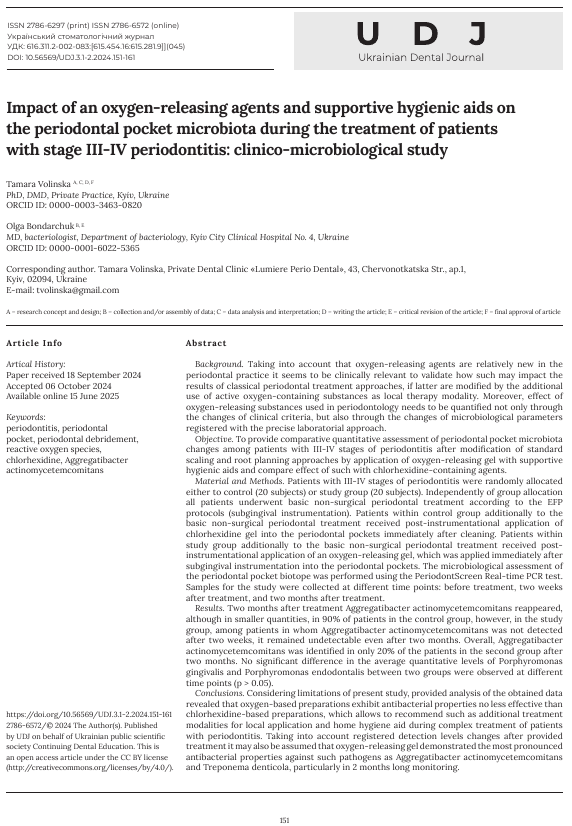Impact of an oxygen-releasing agents and supportive hygienic aids on the periodontal pocket microbiota during the treatment of patients with stage III-IV periodontitis: clinico-microbiological study
DOI:
https://doi.org/10.56569/UDJ.3.1-2.2024.151-161Keywords:
periodontitis, periodontal pocket, periodontal debridement, reactive oxygen species, chlorhexidine, Aggregatibacter actinomycetemcomitansAbstract
Background. Taking into account that oxygen-releasing agents are relatively new in the periodontal practice it seems to be clinically relevant to validate how such may impact the results of classical periodontal treatment approaches, if latter are modified by the additional use of active oxygen-containing substances as local therapy modality. Moreover, effect of oxygen-releasing substances used in periodontology needs to be quantified not only through the changes of clinical criteria, but also through the changes of microbiological parameters registered with the precise laboratorial approach.
Objective. To provide comparative quantitative assessment of periodontal pocket microbiota changes among patients with III-IV stages of periodontitis after modification of standard scaling and root planning approaches by application of oxygen-releasing gel with supportive hygienic aids and compare effect of such with chlorhexidine-containing agents.
Material and Methods. Patients with III-IV stages of periodontitis were randomly allocated either to control (20 subjects) or study group (20 subjects). Independently of group allocation all patients underwent basic non-surgical periodontal treatment according to the EFP protocols (subgingival instrumentation). Patients within control group additionally to the basic non-surgical periodontal treatment received post-instrumentational application of chlorhexidine gel into the periodontal pockets immediately after cleaning. Patients within study group additionally to the basic non-surgical periodontal treatment received post-instrumentational application of an oxygen-releasing gel, which was applied immediately after subgingival instrumentation into the periodontal pockets. The microbiological assessment of the periodontal pocket biotope was performed using the PeriodontScreen Real-time PCR test. Samples for the study were collected at different time points: before treatment, two weeks after treatment, and two months after treatment.
Results. Two months after treatment Aggregatibacter actinomycetemcomitans reappeared, although in smaller quantities, in 90% of patients in the control group, however, in the study group, among patients in whom Aggregatibacter actinomycetemcomitans was not detected after two weeks, it remained undetectable even after two months. Overall, Aggregatibacter actinomycetemcomitans was identified in only 20% of the patients in the second group after two months. No significant difference in the average quantitative levels of Porphyromonas gingivalis and Porphyromonas endodontalis between two groups were observed at different time points (p > 0.05).
Conclusions. Considering limitations of present study, provided analysis of the obtained data revealed that oxygen-based preparations exhibit antibacterial properties no less effective than chlorhexidine-based preparations, which allows to recommend such as additional treatment modalities for local application and home hygiene aid during complex treatment of patients with periodontitis. Taking into account registered detection levels changes after provided treatment it may also be assumed that oxygen-releasing gel demonstrated the most pronounced antibacterial properties against such pathogens as Aggregatibacter actinomycetemcomitans and Treponema denticola, particularly in 2 months long monitoring.
Conflict of Interest
Authors do not have any potential conflict of interests that may influence the decision to publish this article.
Funding
No funding was received to assist in preparation and conduction of this research, as well as in composition of this article.
References
1. James P, Worthington HV, Parnell C, Harding M, Lamont T, Cheung A, Whelton H, Riley P. Chlorhexidine mouthrinse as an adjunctive treatment for gingival health. Cochrane Database Syst Rev. 2017;2017(3):CD008676. doi: https://doi.org/10.1002/14651858.CD008676.pub2
2. Retamal-Valdes B, Soares GM, Stewart B, Figueiredo LC, Faveri M, Miller S, Zhang YP, Feres M. Effectiveness of a pre-procedural mouthwash in reducing bacteria in dental aerosols: randomized clinical trial. Braz Oral Res. 2017;31(0):e21. doi: https://doi.org/10.1590/1807-3107BOR-2017.vol31.0021
3. Jones CG. Chlorhexidine: is it still the gold standard?. Periodontol 2000. 1997;15:55-62. doi: https://doi.org/10.1111/j.1600-0757.1997.tb00105.x
4. Ambrogi V, Pietrella D, Nocchetti M, Casagrande S, Moretti V, De Marco S, Ricci M. Montmorillonite–chitosan–chlorhexidine composite films with antibiofilm activity and improved cytotoxicity for wound dressing. J Colloid Interface Sci. 2017;491:265-72. doi: https://doi.org/10.1016/j.jcis.2016.12.058
5. Stewart B, Shibli JA, Araujo M, Figueiredo LC, Panagakos F, Matarazzo F, Mairink R, Onuma T, Faveri M, Retamal‐Valdes B, Feres M. Effects of a toothpaste containing 0.3% triclosan on periodontal parameters of subjects enrolled in a regular maintenance program: A secondary analysis of a 2‐year randomized clinical trial. J Periodontol. 2020;91(5):596-605. doi: https://doi.org/10.1002/JPER.18-050
6. Costa X, Laguna E, Herrera D, Serrano J, Alonso B, Sanz M. Efficacy of a new mouth rinse formulation based on 0.07% cetylpyridinium chloride in the control of plaque and gingivitis: a 6‐month randomized clinical trial. J Clin Periodontol. 2013;40(11):1007-15. doi: https://doi.org/10.1111/jcpe.12158
7. Botushanov PI, Grigorov GI, Aleksandrov GA. A clinical study of a silicate toothpaste with extract from propolis. Folia Med. 2001;43(1-2):28-30
8. Pradeep AR, Agarwal E, Naik SB. Clinical and microbiologic effects of commercially available dentifrice containing aloe vera: a randomized controlled clinical trial. J Periodontol. 2012;83(6):797-804. doi: https://doi.org/10.1902/jop.2011.110371
9. Hammer KA, Carson CF, Riley TV. Influence of organic matter, cations and surfactants on the antimicrobial activity of Melaleuca alternifolia (tea tree) oil in vitro. J Appl Microbiol. 1999;86(3):446-52. doi: https://doi.org/10.1046/j.1365-2672.1999.00684.x
10. Swamy MK, Akhtar MS, Sinniah UR. Antimicrobial properties of plant essential oils against human pathogens and their mode of action: an updated review. Evid Based Complement Alternat Med. 2016;2016(1):3012462. doi: https://doi.org/10.1155/2016/3012462
11. Carson CF, Hammer KA, Riley TV. Melaleuca alternifolia (tea tree) oil: a review of antimicrobial and other medicinal properties. Clinl Microbiol Rev. 2006;19(1):50-62. doi: https://doi.org/10.1128/CMR.19.1.50-62.2006
12. Cunha EJ, Auersvald CM, Deliberador TM, Gonzaga CC, Esteban Florez FL, Correr GM, Storrer CL. Effects of active oxygen toothpaste in supragingival biofilm reduction: a randomized controlled clinical trial. Int J Dent. 2019;2019(1):3938214. doi: https://doi.org/10.1155/2019/3938214
13. Serrano J, Escribano M, Roldan S, Martin C, Herrera D. Efficacy of adjunctive anti‐plaque chemical agents in managing gingivitis: a systematic review and meta‐analysis. J Clin Periodontol. 2015;42:S106-38. doi: https://doi.org/10.1111/jcpe.12331
14. Dalton SJ, Whiting CV, Bailey JR, Mitchell DC, Tarlton JF. Mechanisms of chronic skin ulceration linking lactate, transforming growth factor-β, vascular endothelial growth factor, collagen remodeling, collagen stability, and defective angiogenesis. J Invest Dermatol. 2007;127(4):958-68. doi: https://doi.org/10.1038/sj.jid.5700651
15. Deliberador TM, Weiss SG, Rychuv F, Cordeiro G, Ten Cate MC, Leonardi L, Brancher JA, Scariot R. Comparative analysis in vitro of the application of blue® m oral gel versus chlorhexidine on Porphyromonas gingivalis: A pilot study. Adv Microbiol. 2020;10(04):194. doi: https://doi.org/10.4236/aim.2020.104015
16. Koul A, Kabra R, Chopra R, Sharma N, Sekhar V. Comparative evaluation of oxygen releasing formula (Blue-M Gel®) and chlorhexidine gel as an adjunct with scaling and root planing in the management of patients with chronic periodontitis–A clinico-microbiological study. J Dent Spec. 2023;7(2):111-7. doi: https://doi.org/10.18231/j.jds.2019.026
17. Juliana H, Tarek S. Comparative study of the effect of BlueM active oxygen gel and coe-pack dressing on postoperative surgical depigmentation healing. Saudi Dent J. 2022;34(4):328-34. doi: https://doi.org/10.1016/j.sdentj.2022.04.005
18. Alayadi H, Talakey A, Aldulaijan H, Shaheen MY. The Impact of a Topical Oxygen-Releasing Gel (blue® m) on Deep Periodontal Pockets: A Case Report. Medicina. 2024;60(9):1527. doi: https://doi.org/10.3390/medicina60091527
19. Singh A, Vasudevan S, Palle AR, Atchuta A, Bhadauriya S. Comparative evaluation of scaling and root planing with and without oxygen-releasing gel in the treatment of chronic periodontitis: A split-mouth study. J Contemp Dent Pract. 2024;25(5):445-52. doi: https://doi.org/10.5005/jp-journals-10024-3689
20. Kumar M, Meher B, Mishra L, Panda S, Sokolowski K, Lapinska B. Evaluation of Blue® m Mouthwash vs. Chlorhexidine Mouthwash in Patients with Gingivitis—A Pilot Study. Appl Sci. 2024;14(24):11862. doi: https://doi.org/10.3390/app142411862
21. Haffajee AD, Cugini MA, Dibart S, Smith C, Kent Jr RL, Socransky SS. The effect of SRP on the clinical and microbiological parameters of periodontal diseases. J Clin Periodontol. 1997;24(5):324-34. doi: https://doi.org/10.1111/j.1600-051x.1997.tb00765.x.
22. Bonito AJ, Lux L, Lohr KN. Impact of local adjuncts to scaling and root planing in periodontal disease therapy: a systematic review. J Periodontol. 2005;76(8):1227-36. doi: https://doi.org/10.1902/jop.2005.76.8.1227.
23. Cobb CM. Clinical significance of non-surgical periodontal therapy: an evidence-based perspective of scaling and root planing. J Clin Periodontol. 2002;29:6-16.
24. Sanz M, Herrera D, Kebschull M, Chapple I, Jepsen S, Berglundh T, Sculean A, Tonetti MS, EFP Workshop Participants and Methodological Consultants, Merete Aass A, Aimetti M. Treatment of stage I–III periodontitis—The EFP S3 level clinical practice guideline. J Clin Periodontol. 2020;47:4-60. doi: https://doi.org/10.1111/jcpe.13290
25. Herrera D, Sanz M, Kebschull M, Jepsen S, Sculean A, Berglundh T, Papapanou PN, Chapple I, Tonetti MS, EFP Workshop Participants and Methodological Consultant, Aimetti M. Treatment of stage IV periodontitis: the EFP S3 level clinical practice guideline. J Clin Periodontol. 2022;49:4-71. doi: https://doi.org/10.1111/jcpe.13639
26. Kuret S, Kalajzic N, Ruzdjak M, Grahovac B, Jezina Buselic MA, Sardelić S, Delic A, Susak L, Sutlovic D. Real-Time PCR Method as Diagnostic Tool for Detection of Periodontal Pathogens in Patients with Periodontitis. Int J Mol Sci. 2024;25(10):5097. doi: https://doi.org/10.3390/ijms25105097
27. Nastych O, Goncharuk-Khomyn M, Foros A, Cavalcanti A, Yavuz I, Tsaryk V. Comparison of bacterial load parameters in subgingival plaque during peri-implantitis and periodontitis using the RT-PCR method. Acta Stomatol Croat. 2020;54(1):32-43. doi: https://doi.org/10.15644/asc54/1/4
28. Boutaga K, Van Winkelhoff AJ, Vandenbroucke‐Grauls CM, Savelkoul PH. The additional value of real‐time PCR in the quantitative detection of periodontal pathogens. J Clin Periodontol. 2006;33(6):427-33. doi: https://doi.org/10.1111/j.1600-051X.2006.00925.x
29. Greenstein G. Local drug delivery in the treatment of periodontal diseases: assessing the clinical significance of the results. J Periodontol. 2006;77(4):565-78. doi: https://doi.org/10.1902/jop.2006.050140
30. Kalsi R, Vandana KL, Prakash S. Effect of local drug delivery in chronic periodontitis patients: A meta-analysis. J Indian Soc Periodontol. 2011;15(4):304-9. doi: https://doi.org/10.4103/0972-124X.92559
31. Deus FP, Ouanounou A. Chlorhexidine in dentistry: pharmacology, uses, and adverse effects. Int Dent J. 2022;72(3):269-77. doi: https://doi.org/10.1016/j.identj.2022.01.005
32. Niveda R, Kaarthikeyan G. Effect of oxygen releasing oral gel compared to chlorhexidine gel in the treatment of periodontitis. J Pharm Res Int. 2020;32:75-82. doi: https://doi.org/10.9734/jpri/2020/v32i1930711
33. Basudan AM, Abas I, Shaheen MY, Alghamdi HS. Effectiveness of Topical Oxygen Therapy in Gingivitis and Periodontitis: Clinical Case Reports and Review of the Literature. J Clin Med. 2024;13(5):1451. doi: https://doi.org/10.3390/jcm13051451
34. Shaheen MY, Abas I, Basudan AM, Alghamdi HS. Local Oxygen-Based Therapy (blue® m) for Treatment of Peri-Implant Disease: Clinical Case Presentation and Review of Literature about Conventional Local Adjunct Therapies. Medicina. 2024 8;60(3):447. doi: https://doi.org/10.3390/medicina60030447
35. Garcia VG, Miessi DM, da Rocha TE, Gomes NA, Rodrigues JV, Ervolino E, de Freitas RM, Wainwright M, de Molon RS, Theodoro LH. Shedding Light on the Therapeutic Efficiency of Oxygen-Releasing Gel and Photodynamic Therapy as Adjuvants in the Treatment of Experimental Periodontitis. Photobiomodul Photomed Laser Surg. 2025;43(4):159-72. doi: https://doi.org/10.1089/photob.2024.0083
36. Bali S, Bhargava A, Arora S, Aggarwal P, Nautiyal A, Singhal D. Oxygen-releasing Gel vs 0.2% Chlorhexidine Gel as an Adjuvant to Scaling and Root Planing: A Randomized Controlled Trial. World J Dent. 2022;13(S2):S220-4. doi: https://doi.org/10.5005/jp-journals-10015-2137
37. Nedumaran N, Rajasekar A. Clinical and Biochemical Effects of Antioxidant Gel as a Local Drug Delivery Agent in Stage II Grade A Periodontitis Patients: A Prospective Clinical Study. Cureus. 2024;16(6):e61707. doi: https://doi.org/10.7759/cureus.61707
38. Agarwal S, Bali S, Aggarwal P, Garg A, Nautiyal A, Sharma M. Evaluation of the Efficacy of Oxygen-releasing Gel as an Adjunct to Scaling and Root Planing in Chronic Periodontitis: A Split-mouth Randomized Controlled Trial. J Int Clin Dent Res Organ. 2024;16(2):157-62. doi: https://doi.org/10.4103/jicdro.jicdro_70_23
39. Agarwal R, Kamble PS, Mangalekar SB, Nayak Y, Sawant P, Chatterjee A. A comparative evaluation of efficacy of oxygen releasing formula gel, chlorhexidine gel and scaling and root planing alone in the management of chronic periodontitis–A clinico-microbiological study. Eur Chem Bull. 2023; 12(Si6):4520 – 4536
40. Shibli JA, Rocha TF, Coelho F, de Oliveira Capote TS, Saska S, Melo MA, Pingueiro JM, de Faveri M, Bueno-Silva B. Metabolic activity of hydro-carbon-oxo-borate on a multispecies subgingival periodontal biofilm: a short communication. Clin Oral Investig. 2021;25:5945-53. doi: https://doi.org/10.1007/s00784-021-03900-0

Downloads
Published
Issue
Section
Categories
License
Copyright (c) 2024 The Author(s)

This work is licensed under a Creative Commons Attribution 4.0 International License.








